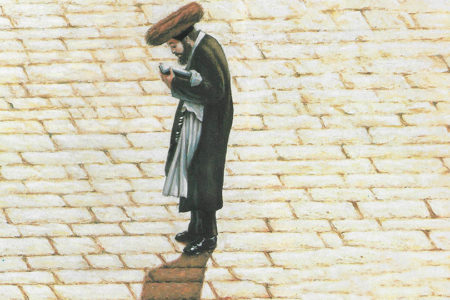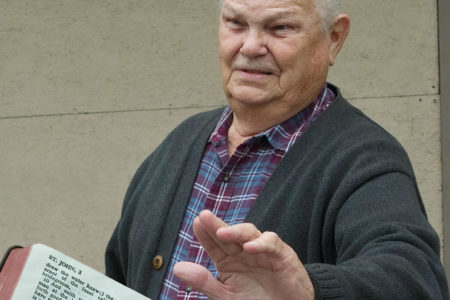An Evaluation of Christian Reconstructionism Concluded
Introduction
The two previous articles (Christian Reconstructionism, Further Evaluation) in this five-article series focused on several problems related to the Reconstructionist views of history and eschatology, Matthew 24, the Book of the Revelation, the 70 weeks of Daniel 9, and Israel as a nation. This final article examines problems associated with another view of Reconstructionism.
The Reconstructionist View of the Mosaic Law
Reconstructionists teach that the Mosaic Law was God’s fullest revelation and greatest means of execution of the dominion mandate given to man at creation to subdue the earth on behalf of God and thereby establish the Kingdom of God on this planet. They believe that God intends the Mosaic Law to be in effect throughout history and to be the rule of life for the people of all nations and cultures. To their way of thinking, it was because Israel disobeyed the Mosaic Law and the Gentiles failed to accept it that the dominion mandate was not fulfilled in Old Testament times.
Reconstructionists strongly reject the idea that the Mosaic Law was abolished by God when Christ died. They believe that during His First Coming, Christ established and restored the Law to full measure as the rule of life for the whole world.. Instead of His death abolishing the Mosaic Law, it enabled man to keep the Law.
Reconstructionists insist that God requires all nations, institutions, cultures, and individuals to be subject to the civil and moral aspects of the Mosaic Law. They teach that all the blessings for obedience to the Law and curses for disobedience pronounced by God upon Israel in Deuteronomy 28 are in effect today. Reconstructionists are convinced that there are only two alternatives open to nations, institutions, cultures, and individuals—obedience to the Mosaic Law or humanistic self-rule and lawlessness. To the Reconstructionist way of thinking, Christians are dead to the Mosaic Law as the means of justification but not as a rule of life. Obedience to the Law is required of the Christian for practical living. Law keeping is the Christian’s means of sanctification.
Problems with the Reconstructionist View of the Mosaic Law
The Reconstructionist view of the Law has some problems. First, did God intend the Gentiles to adopt the Mosaic Law in Old Testament times, and does He intend the Law to be the rule of life for all nations and cultures? Contrary to this view, the Scriptures assert that God gave the Law exclusively to Israel. Moses stated the following concerning Israel: “And what nation is there so great, that hath statutes and ordinances as righteous as all this law…?” (Dt. 4:8). Psalm 147:19–20 declares, “He showeth his word unto Jacob, his statutes and his ordinances unto Israel. He hath not dealt so with any nation; and as for his ordinances, they have not known them. Praise ye the Lᴏʀᴅ.” The Apostle Paul stated that the Gentiles “have not the law” (Rom. 2:14), that the Jews had an advantage over the Gentiles because “unto them were committed the oracles of God” (Rom. 3:2), and that “the giving of the law” pertained to the Israelites (Rom. 9:4).
In addition, nowhere do the Scriptures record a divine command for Israel to take the Law to the Gentiles. If God intended the Gentiles to adopt the Mosaic Law, and if He intended it to be the rule of life for all nations and cultures, why did He give the Law to only one nation, and why did He not command that nation to take the Law to all other nations?
Second, if the Mosaic Law was the fullest revelation and greatest means of execution of the dominion mandate and God intended the Mosaic Law to be in effect throughout history, why did God promise to establish a new covenant after the Mosaic Law Covenant had been in effect for many centuries? In Jeremiah 31:31 God made the following promise: “Behold, the days come, saith the Lᴏʀᴅ, that I will make a new covenant with the house of Israel, and with the house of Judah.”
The very fact that God called the future covenant “new” implies four things: (1) that there was another covenant already in existence; (2) that, by contrast, the other covenant could be called the “Old Covenant” (3) that eventually the Old Covenant would be done away with and replaced by the new one; and (4) that the Old Covenant was inadequate in some way.
Several of these implications were recognized by the writer of the Book of Hebrews. In 8:7, after teaching that Jesus is the mediator of a covenant that is better than the Old Covenant and was established upon better promises than those of the Old Covenant, he declared, “For if that first covenant had been faultless, then should no place have been sought for the second.” Then, in order to explain and substantiate this declaration, the writer quoted the Jeremiah 31 promise of a New Covenant (vv. 8–12) and stated, “In that he saith, A new covenant, he hath made the first old. Now that which decayeth and groweth old is ready to vanish away” (v. 13).
The writer of Hebrews understood the Old Covenant to be inadequate in some way and to be temporary. It was done away and replaced by the New Covenant, which is superior to the Old Covenant. The writer also recognized that this transition between the Old and New Covenants took place through the First Coming ministry of Christ.
But what exactly was the Old Covenant? In Jeremiah 31:31 God identified the Old Covenant as the one He made with Israel during the time of her exodus from Egypt. The Scriptures clearly identify that covenant with the Ten Commandments, which were written on tablets of stone while Israel was encamped at Mount Sinai. Exodus 34:4, 27–28 states the following concerning Moses:
And … Moses rose up early in the morning, and went up unto Mount Sinai as the LORD had commanded him, and took in his hand the two tables of stone … And the LORD said unto Moses, Write thou these words; for after the tenor of these words I have made a covenant with thee and with Israel … And he wrote upon the tables the words of the covenant, the ten commandments.
After rehearsing with the Israelites their experience with God at Mount Sinai (Dt. 4:10–12), Moses said, “And he declared unto you his covenant, which he commanded you to perform, even ten commandments; and he wrote them upon two tables of stone” (v. 13). Other passages make this same identification of the Old Covenant with the Ten Commandments (i.e., Dt. 4:23; 5:1–22; 9:9–11, 15; 1 Ki. 8:9; Heb. 9:4). Although the Old Covenant also contained many civil and ceremonial precepts, the Ten Commandments were its moral heart.
In addition to identifying the Old Covenant, in Jeremiah 31:32 God emphasized that the New Covenant would be considerably different from the Old Covenant. Having promised the New Covenant in verse 31, He stated the following concerning it in verse 32: “Not according to the covenant that I made with their fathers in the day that I took them by the hand to bring them out of the land of Egypt.”
Concerning this difference, Habel writes, “The ‘new,’ which God alone could introduce, would break sharply with the past. This ‘new covenant’ stood in contrast to all past renewals (for example, 2 Kings 23:1–3) of the covenant. This new covenant can hardly be defined in terms of the old … The ‘not like’ of v. 32 makes this antithesis explicit.”*
Anderson asserts that the promise of the New Covenant “cannot be understood as reactualization of the past sacred history. He speaks of a new covenant, not a covenant renewal, and thereby assumes a radical break with the Mosaic tradition.”*
Calvin gave the reason for God’s emphasizing the difference between the Old and New Covenants: “Here he clearly distinguishes the new covenant from the Law. The contrast ought to be borne in mind; for no one of the Jews thought it possible that God would add anything better to the Law … that they thought that heaven and earth could sooner be blended together, than that any change should be made in the Law; and at the same time they held most tenaciously what God had only for a time instituted. It was therefore necessary that the Law should be here contrasted with the new covenant, that the Jews might know that the favour in reserve for them would be far more excellent than what had been formerly manifested to the fathers.”*
In 2 Corinthians 3, the Apostle Paul also emphasized the difference between the Old Covenant (“in tables of stone,” vv. 3, 7) and the New Covenant (“in fleshy tables of the heart,” vv. 3, 6). The Old Covenant was a ministry of condemnation, but the New Covenant is a ministry of righteousness (v. 9). The Old Covenant ministry had glory, but the New Covenant ministry exceeds in glory (vv. 7–11). The Old Covenant “is done away,” but the New Covenant remains (v. 11). To summarize the issues of this second problem, God promised the New Covenant because the Old Covenant (which included the Ten Commandments on stone) was inadequate in some way. The New Covenant was to be different from and superior to the Old. The Old Covenant was temporary; it was done away with and replaced by the New Covenant through the First Coming ministry of Christ.
The Indivisible Nature of the Mosaic Law
It is important to note that, although the Mosaic Law had three aspects (moral, civil, and ceremonial), the Scriptures teach that it was indivisible by nature. In Galatians 3:10 Paul declared, “For as many as are of the works of the law are under the curse; for it is written, Cursed is everyone that continueth not in all things which are written in the book of the law, to do them.” This statement implies that the person who attempted to keep the Mosaic Law was required to keep every aspect of the Law perfectly and continuously. Even one failure brought the curse of God.
In Galatians 5:3 Paul wrote, “For I testify again to every man that is circumcised, that he is a debtor to do the whole law.” Paul was asserting that submission to one part of the Law (the ceremonial aspect of circumcision) obligated a person to keep every aspect of the Law.
James asserted, “For whosoever shall keep the whole law, and yet offend in one point, he is guilty of all” (Jas. 2:10). This indicates that the breaking of only one part of the Mosaic Law made a person guilty of breaking the entire Law. This could be true only if the Mosaic Law were an indivisible unit.
Since the Mosaic Law is indivisible by nature, the person who places himself under any aspect of it obligates himself to keep every aspect (the moral, civil, and ceremonial) perfectly and continuously. In like manner, to place any nation or culture under any aspect of the Mosaic Law is to obligate it to keep every aspect of the Law, even all the ritual of the ceremonial aspect.
The Temporary Nature of the Mosaic Law
The earlier discussion concerning the New Covenant indicated that the Old Covenant, or Mosaic Law, was temporary. Other biblical passages indicate the same. For example, in Galatians 3:19 Paul declared that the Mosaic Law was to be in effect only until the First Coming ministry of Christ. Paul enlarged this concept of the temporary nature of the Law by teaching that the Law functioned as a schoolmaster (an external moral restrainer or disciplinarian) only until the faith, which came through Christ’s earthly ministry, arrived (Gal. 3:23–25).
In Ephesians 2:15–16 Paul declared that the Mosaic Law was abolished by Christ through His physical death on the cross. The word translated “abolished” meant “to put out of business” or “to dissolve business relationships.”* Paul cannot mean that Christ’s death abolished the Mosaic Law as a means of justification, for the Law never functioned in that way (Rom. 3:28; Gal. 2:16, 21; 3:11). In fact, instead of saving people, the Law was a ministry of condemnation, death, and wrath (Rom. 4:15: 2 Cor. 3:7. 9). Paul meant that from the time God met with Israel at Mount Sinai to the time of Christ’s death, God employed the Mosaic Law as a rule of life (as His way of administering His moral absolutes) over Israel. But when Christ died, God stopped employing the Mosaic Law as a rule of life; He dissolved His relationship with it; He put the Law out of business.
According to Hebrews 7, the Old Testament indicated that the Aaronic priesthood was temporary and would be replaced by a priest after the order of Melchizedek. On that basis, the writer of Hebrews carried his teaching a step further by declaring, “For the priesthood being changed, there is made of necessity a change also of the law” (v. 12). F. F. Bruce stated that the word translated “change” in this statement “implies not merely change but abrogation.”* Thus, the writer of Hebrews was indicating that when Christ abolished the Aaronic priesthood through the establishment of His Melchizedekan priesthood ministry, the Mosaic Law that established the Aaronic priesthood was also abolished.
Concerning this teaching by the writer of Hebrews, F. F. Bruce declared, “Nor is it only the Aaronic priesthood which must be superseded. That priesthood was instituted under the Mosaic law, and was so integral to it that a change in the priesthood carries with it inevitably a change in the law. If the Aaronic priesthood was instituted for a temporary purpose, to be brought to an end when the age of fulfillment dawned, the same must be true of the law under which the priesthood was introduced. So by his own independent line of argument our author reaches the same conclusion as Paul: the law was a temporary provision, ‘our tutor to bring us unto Christ … but now that faith is come, we are no longer under a tutor’ (Gal. 3:24) … If we like, we may say that Paul has the moral law mainly in mind, whereas the author of Hebrews is concerned more with the ceremonial law … although the distinction between the moral and ceremonial law is one drawn by Christian theologians, not by those who accepted the whole law as the will of God, nor yet by the New Testament writers. But in principle Paul and our author are agreed that the law was a temporary dispensation of God, valid only until Christ came to inaugurate the age of perfection.”*
The implication of all this is that the Mosaic Law, including the Ten Commandments, was done away with as a rule of life when Christ died.
An Alternative to the Mosaic Law and Lawlessness
Is it true that there are only two alternatives open to nations, institutions, cultures, and individuals—obedience to the Mosaic Law or humanistic self-rule and lawlessness? In response to this question, several important things should be noted. First, the abolition of the whole Mosaic Law does not set man free from the eternal, unchangeable, moral absolutes of God. Although the Mosaic Law did present God’s moral absolutes, it was only one of His ways of administering His eternal, unchangeable absolutes to one nation of people (Israel) during one period of history (from Sinai to the death of Christ). Thus, the abolition of the Mosaic Law involved only the abolition of one way of God’s administering His absolutes, not the abolition of the absolutes themselves.
Second, since God’s moral absolutes are eternal and unchangeable, they were in effect before God instituted the Mosaic Law at Mount Sinai. This means that prior to Mount Sinai God administered His unchangeable absolutes in ways other than the Mosaic Law. It also means that God’s eternal moral absolutes can be in effect without the Mosaic Law being in effect.
Third, it should be noted that before the Mosaic Law there were people who lived righteous lives in conformity to God’s moral absolutes. Abel (Heb. 11:4), Enoch (Gen. 5:22, 24; Heb. 11:5), Noah (Gen. 6:9; Ezek. 14:14, 20), and Job (Job 1:8; 2:3; Ezek. 14:14, 20) are examples of such people. God placed Noah and Job (who lived without the Mosaic Law) in the same category of righteousness as Daniel (who lived under the Mosaic Law) (Ezek. 14:14, 20). The fact that some people lived righteous lives that conformed to God’s moral absolutes before the Mosaic Law was instituted indicates two things: People can be related to the eternal, unchangeable, moral absolutes of God without being under any aspect of the Mosaic Law as a rule of life; and it is possible for a person to be free from the whole Mosaic Law, including the Ten Commandments, without being lawless.
Fourth, the Old Covenant Mosaic Law was an external way of God’s administering His absolutes. That Law was written on stone outside the people. Since the death of Christ, God has been administering His moral absolutes in the internal way of the New Covenant, with His rule of life written in people’s hearts (Jer. 31:33; Ezek. 36:26–27; 2 Cor. 3:3). This internal way of the New Covenant is different from and superior to the external way of the Old Covenant Mosaic Law (2 Cor. 3:3–11).* The moral absolutes have not changed, but God’s way of administering those absolutes has changed.
Thus, a third alternative is available—a godly life, involving freedom from both the whole Mosaic Law and lawlessness, as a result of having the internal administration of God’s rule related to the New Covenant.








